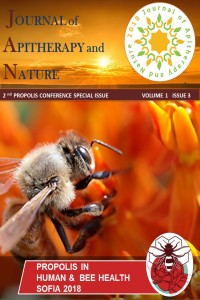Öz
Propolis is a bee-keeping product of
increasing interest as it has been used widely in food industry as well as in
cosmetics; while its chemical composition is highly variable and depends mainly
on the local flora as well as the geographic
and climatic differences in the collection sites. Therefore it is necessary to
characterize propolis, chemistry in order to confirm quality and safe use.
As a part of our systematic research on
different propolis from all over the world, we report in this study the chemical
analyses of two Euroasian samples from Armenia and Georgia respectively, which to the best of our knowledge have not been
studied before.
All chemical analyses were performed by
GC/MS using silylation procedure1. According to our results, both
samples showed the characteristic identity profile of a typical propolis from
Temperate zone2, as they contained mainly aromatic acids
(p-coumaric, caffeic and ferulic acids), esters of phenolic acids (pentenyl and
phenylethyl caffeates), flavonoids and chalcones (galangin, pinocembrin,
pinobanksin and its 3-O-acetate, as well as pinocembrin, pinobanksin and
pinostrobin chalcones).
Furthermore, their total phenolic content
was determined by the Folin-Ciocalteu method showing comparable high phenolics
in both samples, which is in accordance with the results from GC-MS analysis.
The ethanolic extracts were also assayed
for their antimicrobial activity against nine human pathogenic bacteria and
fungi, showing an interesting profile, while they exerted a more specific
activity towards the Gram positive studied strains.
Acknowledgments: The authors would like to
thank Prof. Alexander Panossian (Head of Research & Development –
Swedish Herbal Institute, Sweden) for providing the
Armenian propolis sample.
Anahtar Kelimeler
Kaynakça
- 1. Popova Μ., Chinou Ι., Marekov Ι. and Bankova V. (2009). Terpenes with antimicrobial activity from Cretan propolis. Phytochemistry, 70: 1262-1271.
- 2. Bankova V., de Castro S.L. and Marcucci M.C. (2000). Propolis: recent advances in chemistry and plant origin.Apidologie 2000, 31, 3-15.
Öz
Kaynakça
- 1. Popova Μ., Chinou Ι., Marekov Ι. and Bankova V. (2009). Terpenes with antimicrobial activity from Cretan propolis. Phytochemistry, 70: 1262-1271.
- 2. Bankova V., de Castro S.L. and Marcucci M.C. (2000). Propolis: recent advances in chemistry and plant origin.Apidologie 2000, 31, 3-15.
Ayrıntılar
| Birincil Dil | İngilizce |
|---|---|
| Bölüm | 2nd Propolis Conference Special Issue |
| Yazarlar | |
| Yayımlanma Tarihi | 8 Aralık 2018 |
| Yayımlandığı Sayı | Yıl 2018 Cilt: 1 Sayı: 3 - 2nd Propolis Conference Special Issue |
Kaynak Göster
ASOS Index

